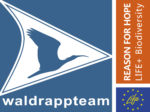Reintroduction of the Northern Bald Ibis
Reason for Hope
Reintroduction of the Northern Bald Ibis is one of the largest European species conservation projects.
The Northern Bald Ibis is a migratory bird which was native in Central Europe until the 17th century, before it became extinct due to the huge hunting pressure. Today the Northern Bald Ibis is one of the most endangered bird species worldwide. In the context of an EU project (LIFE+ Biodiversity), with partners in Austria, Italy and Germany, the species is being reintroduced in Europe. As of the end of 2019, when the LIFE+ project was came to its end, the wild Northern Bald Ibis population comprised 140 birds, which is 18% more than defined in the original project objective (119 wild birds).
The implementation of a comprehensive campaign against illegal bird hunting in Italy has almost halved the proportion of losses caused by poaching. While this rate was 60% in the period prior to the LIFE+ project, these losses have been reduced to 31% in the past six years. This is one of the great successes of the project in terms of general species conservation.
By reducing losses from illegal hunting, electrocutions became the primary cause for Northern Bald Ibis losses. By redirecting funds, the project team was able to implement protective measures in the breeding areas Burghausen and Kuchl as part of two pilot projects. As a result, there were no further cases of electrocution in the respective areas in the past season and it can be assumed that further losses in other large bird species could also be prevented.
The immediate touristic benefit was assessed especially for the city of Burghausen in Bavaria. The colony breeding at the castle is increasingly becoming a tourist attraction and a focal point of nature based tourism. The experts write that the reintroduction of the Northern Bald Ibis in Burghausen anchors the topic of nature conservation and species protection much more strongly in the public consciousness, triggers further nature protection measures, strengthens the work of the local nature conservation groups and promotes local ecotourism.

Reintroduction of the Northern Bald Ibis is one of the largest European species conservation projects.
The Northern Bald Ibis is a migratory bird which was native in Central Europe until the 17th century, before it became extinct due to the huge hunting pressure. Today the Northern Bald Ibis is one of the most endangered bird species worldwide. In the context of an EU project (LIFE+ Biodiversity), with partners in Austria, Italy and Germany, the species is being reintroduced in Europe. As of the end of 2019, when the LIFE+ project was came to its end, the wild Northern Bald Ibis population comprised 140 birds, which is 18% more than defined in the original project objective (119 wild birds).
The implementation of a comprehensive campaign against illegal bird hunting in Italy has almost halved the proportion of losses caused by poaching. While this rate was 60% in the period prior to the LIFE+ project, these losses have been reduced to 31% in the past six years. This is one of the great successes of the project in terms of general species conservation.
By reducing losses from illegal hunting, electrocutions became the primary cause for Northern Bald Ibis losses. By redirecting funds, the project team was able to implement protective measures in the breeding areas Burghausen and Kuchl as part of two pilot projects. As a result, there were no further cases of electrocution in the respective areas in the past season and it can be assumed that further losses in other large bird species could also be prevented.
The immediate touristic benefit was assessed especially for the city of Burghausen in Bavaria. The colony breeding at the castle is increasingly becoming a tourist attraction and a focal point of nature based tourism. The experts write that the reintroduction of the Northern Bald Ibis in Burghausen anchors the topic of nature conservation and species protection much more strongly in the public consciousness, triggers further nature protection measures, strengthens the work of the local nature conservation groups and promotes local ecotourism.


